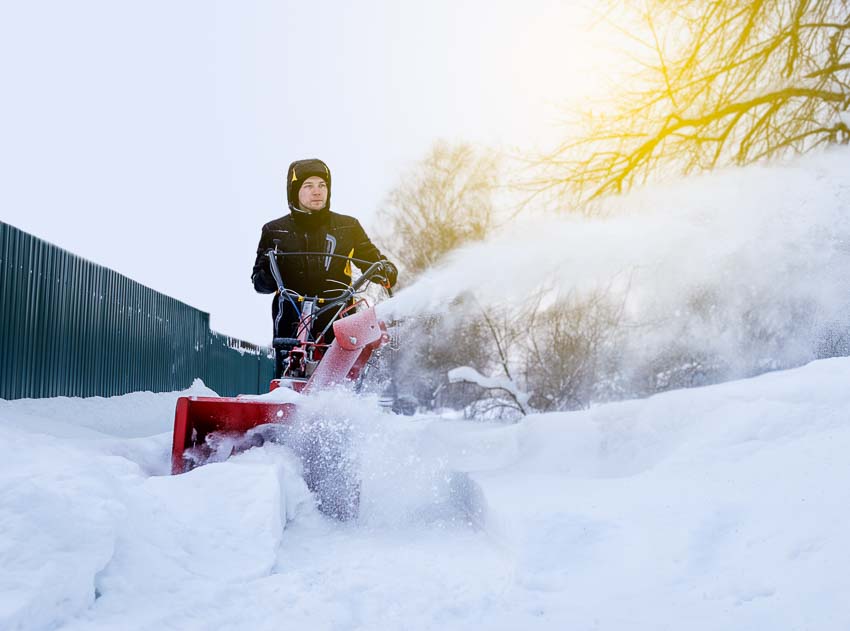Whether you’re new to snow blowing or an old pro, these snow blowing tips and tricks will make your job easier. Learn how to use a snow blower efficiently and safely with this comprehensive guide, including everything from purchasing and maintaining your snow blower to avoiding common mistakes.
The Importance of Snow Blowing in Winter Months
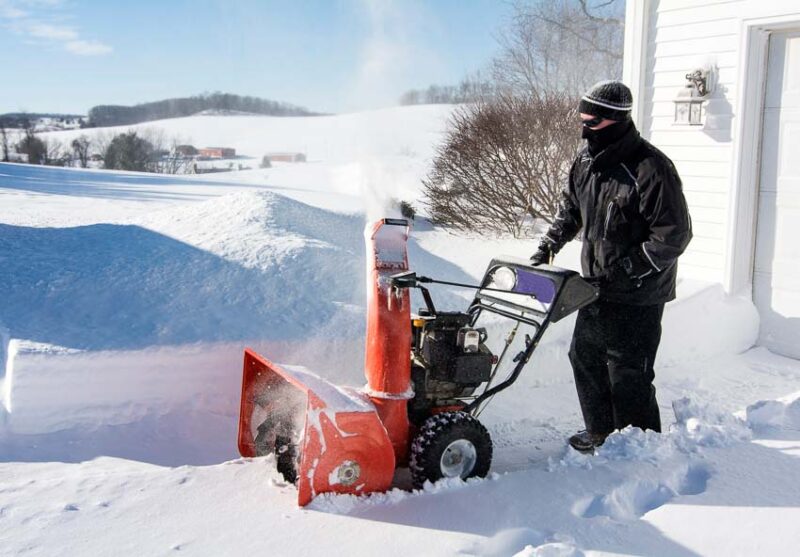
Snow removal is essential if you live in an area that gets a lot of snowfall in the winter. Keeping your driveway and walkways clear of snow makes them safer for you. Moreover, it makes these areas accessible to your visitors and provides access to emergency vehicles.
In some municipalities, you have to clear common areas like driveway approaches and sidewalks within a specific time frame. Using a snow blower makes the job a lot easier than shoveling it by hand.
How to Use a Snow Blower
How does a snow blower work? If you haven’t already, start by reading the owner’s manual that came with your snow blower.
How to Turn On a Snow Blower
The first step in operating a snow blower is starting it up. Most gas-powered models have similar starting mechanisms, but if you have an electric or battery-powered model, it will be a little different.
Pre-start checks
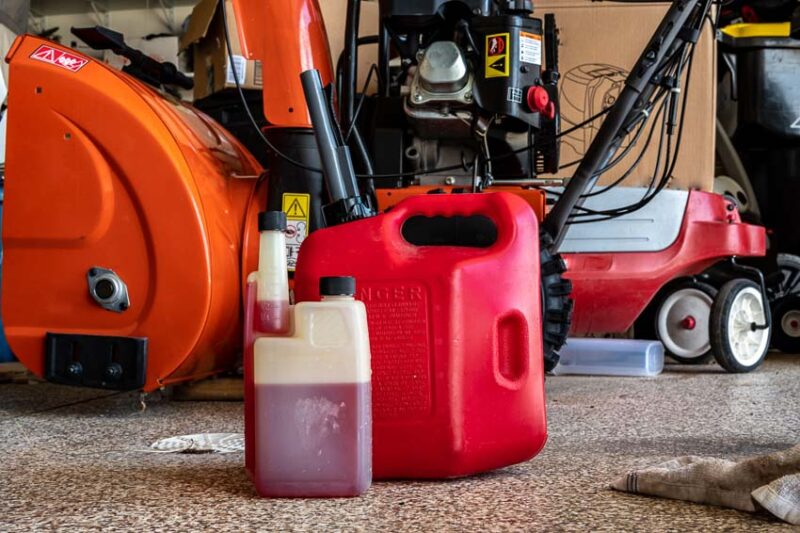
Before starting your snow blower, you must perform a series of pre-start checks.
- Fuel–Check to make sure that there is fuel in the tank. You should store snow blowers at the end of the season with a fuel stabilizer in the tank. Later on, old gas can cause problems and keep it from starting.
- Oil–The oil should be checked before starting and after every 5 hours of operation. Follow the manufacturer’s recommendations for the type of oil to use and how to check the oil in your snow blower. Most models have a dipstick on the cap, which you can read to determine if the oil is low.
- Switches–Ensure all switches and levers are in the right position before starting the snow blower. For example, the auger lever should be in the off position.
- Tires–If your snow blower has wheels instead of tracks, make sure there is adequate tire pressure in them.
- Inspection–Inspect the snow blower to ensure that the belts are in good condition and the shear pins are intact.
The ignition process for gas and electric variants
There are various starting methods depending on the power source and model of snow blower you have. Some snow blowers have electric start, which means you have to plug them in to start, and other models have pull ropes.
Here are the steps to turn on an electric start snow blower:
- Complete the pre-start checks.
- Insert the key in the ignition.
- Move the throttle to the RUN position.
- Turn the choke to the START position.
- Connect the power cord to the snow blower.
- Press the primer bulb three times.
- Push the start button.
If you’re using a pull-start snow blower, follow these steps:
- Insert the key in the ignition.
- Move the throttle to the RUN position.
- Open the fuel shut-off valve.
- Turn the choke to the full (closed) choke position.
- Press the primer bulb three times.
- Pull the rope to start.
- After the engine starts, turn the choke to the open position.
How to Operate a Snow Blower
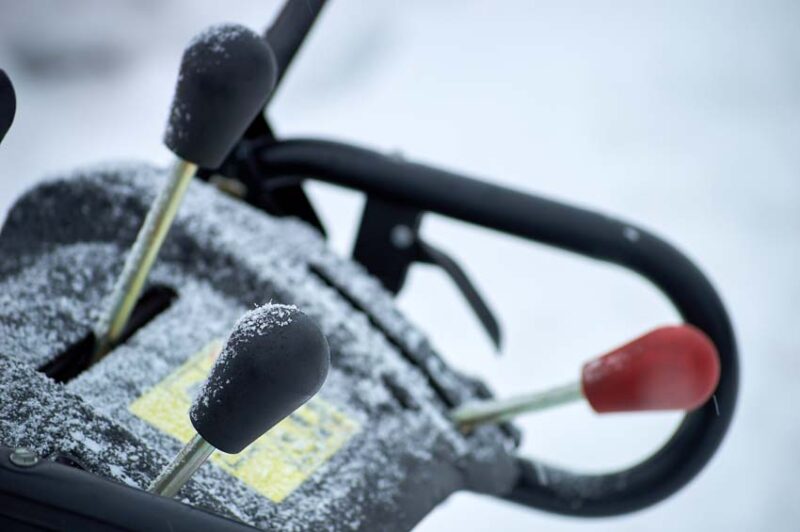
Follow these snow blower operation tips to learn how to operate a snow blower.
The controls
First, familiarize yourself with the controls. You should know how to steer the snow blower, manage the chute direction, and use the clutch to stop the auger from turning before you start it.
Setting the right pace and speed
Going too slow can cause the snow blower to clog, especially in deep or wet snow, and going too fast can cause you to miss spots. Operate the snow blower at a steady speed and try to match the speed with the conditions of the snow.
Most snow blowers have a throttle with a tortoise for SLOW and a rabbit for FAST so you can change the speed of the snow blower.
Directional chute adjustments for optimal snow throwing
It’s a good idea before you head out to the yard to have a plan of where you are going to blow the snow. Snow blower chutes are controlled by a crank chute. As you crank the handle, it turns the chute, and you can rotate it in the opposite direction to blow it the other way.
Snow Blower Tips and Tricks
Beginners can use these snow blower tips and tricks to make snow blowing easier and safer.
Safety
Operator error isn’t just the number one cause of breakdowns, it’s also the leading cause of injuries. Unsafe practices while operating or unclogging snow blowers cause over 6,000 injuries per year.
Learn the essentials of safe snow blowing with these safety tips.
Protective gear essentials
You’ll frequently work in freezing weather, and you’ll have a much easier time if you dress appropriately. A pair of coveralls, warm gloves, a hat, and warm boots will protect your extremities while you’re operating the snow blower.
Wearing goggles will protect your eyes and make it easier to see when winds are whipping powdery snow into your face. You should wear ear protection, which will help keep your ears warm.
What to avoid during operation
Here are some things to avoid when you’re operating a snow blower:
- Avoid loose-fitting clothing that can get caught in moving parts.
- Avoid using drugs or alcohol before operating a snow blower.
- Don’t allow children to operate snow blowers.
- Keep close track of the cord if you’re using an electric snow blower .
Pick up kids’ toys, sticks, rocks, and tools before the first snowfall to avoid problems.
Always stop the machine before trying to unclog the auger or chute. This is the number one cause of injuries when using snow blowers.
Maintenance
Proper maintenance is an integral part of using any type of tools or equipment, and since snow blowers represent a significant investment, it’s a good idea to take care of them to ensure they last for many years.
Seasonal check-ups and storage
In addition to ongoing maintenance, following a seasonal maintenance checklist for your snow blower is the best way to ensure that you properly care for it.
- Check the belts for wear and replace them as needed.
- Check the spark plug and replace it if there are deposits or signs of wear.
- Inspect the auger paddles.
- Check the shave plate and reverse or replace it.
- Check the shear pins.
Maintenance Tips
Shear pins are the number one item that you have to replace on a snow blower. Keep a few on hand so you always have a spare.
Taking a photo of the belts before you remove them is an excellent way to make sure you put them back on right.
The best place to store your snow blower is in a heated garage. If you don’t have that, make sure you store it under a cover and always keep batteries indoors where they can’t freeze.
Wear and tear indicators
The paddles and the scraper bar are designed to protect the snow blower’s housing. It’s normal for them to wear over time. Watch for the following indications of wear and tear:
- A worn scraper bar will leave snow behind.
- It may be time to replace the paddles when the snow blower won’t throw snow as far.
- The paddles have wear indicator holes that indicate when they need to be replaced.
Paddles and scraper bars typically require replacement at the same time.
Buying a Snow Blower
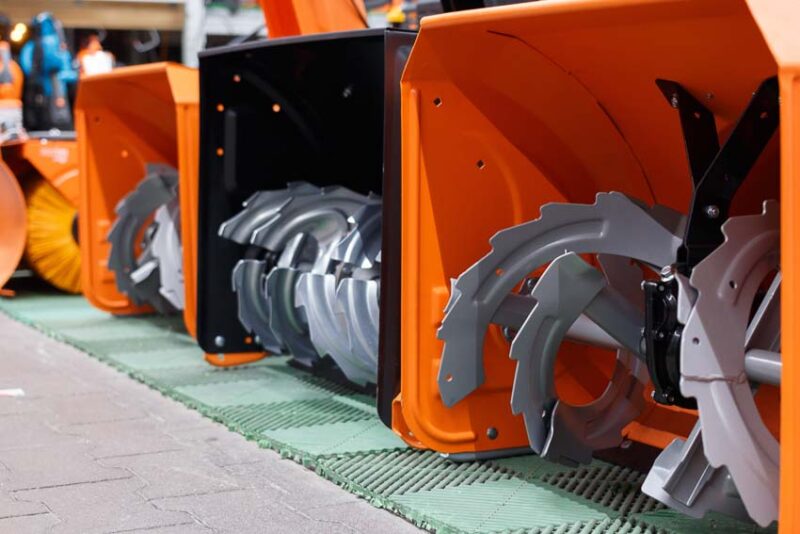
Looking for a new snow blower? Here are a few snow blower buying tips to help you choose the best snow blower for your yard.
Assessing snowfall patterns in your region
Snowfall forecasts are difficult to predict. While you may not need to buy a snow blower to handle the worst winter on record, you should be prepared for heavy snowfalls if you live in an area where that’s possible.
Choose between single-stage and two-stage, or three-stage snow blowers. Single-stage can handle moderate amounts of snow, while 3-stage snow blowers will breeze through and tackle tough jobs with a single pass.
Considering yard size and surface type
A small electric snow blower may be able to handle a concrete driveway and path, but if you have a lot of graveled area to cover, you need a model that can handle those conditions.
Another consideration is slopes. The best snow blower for a steep slope is a 2-stage blower with tracks instead of wheels. They are more expensive, but they will be safer and easier to operate.
Electric Snow Blowers
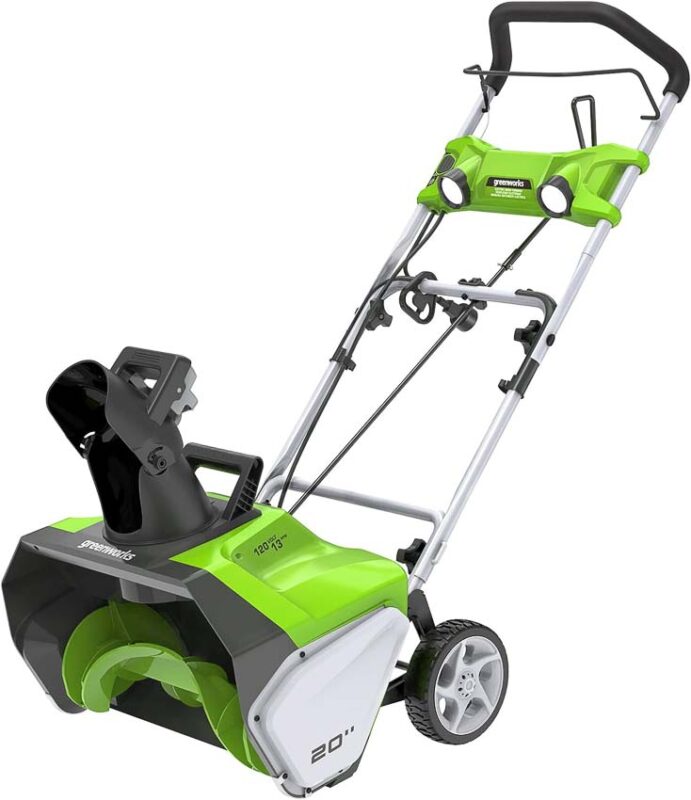
Electric snow blowers have several advantages. You never have to deal with messy fuel or checking the oil. They also weigh less and are easier to maneuver.
In every tool category, corded and cordless electric power tools are on the heels of gas-powered models . Electric snow blowers still fall slightly behind in terms of power and ability to move large amounts of snow, but they are preferred by many because they are so easy to use.
Extension cord management
If a lightweight and low-maintenance snow blower is enticing to you, then an electric snow blower is an excellent choice. However, one of the biggest drawbacks of a corded electric snow blower is the cord.
It’s always a challenge when operating a corded tool, but with a snow blower, visibility is often low, and you have to work your way back and forth across the snow blowing area, making it even more difficult.
The best way to clear a driveway with an electric snow blower is to keep the cord on one side. By working in one direction, it’s easier to keep the cord on one side. Instead of turning around after going in one direction, pull the snow blower backward so that it never passes over the cord.
Optimal conditions for electric snow blower usage
Many gas-powered snow blowers can handle up to 24 inches of snow and cut swaths up to 45 inches wide, depending on the model. At most, electric snow blowers can handle up to a 13-inch depth and a cutting width of 24 inches.
You won’t be able to move heavy loads of snow like the piles left at the end of your driveway by the city’s snow plow, but you can clear your paths and your driveway easily with an easy-to-use and maintain electric snow blower.
Frequently Asked Questions on How to Use a Snow Blower
How often should I clear snow for optimal performance?
Using a snow blower in heavy, dense snow is hard on it and can sometimes result in mechanical failures. It’s much better if you stay on top of the snowfall and clear it as it comes, from the beginning of the season to the end.
Can I use a snow blower on gravel or uneven surfaces?
You can use snow blowers on gravel or uneven surfaces, but you should select a model that’s made for that purpose. Some are made to work best on concrete driveways. For a graveled area, consider getting a two-stage track-driven snow blower.
How do I ensure the longevity of my snow blower’s engine?
Proper maintenance throughout the winter will ensure that your snow blower’s engine lasts for years. You should also follow an end-of-season maintenance checklist to avoid problems with your snow blower.
Why is my snow blower clogging, and how can I prevent it?
Clogged snow can be frustrating when you’re running a snow blower. It’s usually the result of thick, wet snow. Speeding up can reduce problems with clogging, because the slower you go, the slower the snow moves through the snow blower, causing it to clog. You can also try using non-stick snow blower spray on the auger and paddles to reduce clogging.
How do I maintain my electric snow blower’s battery life?
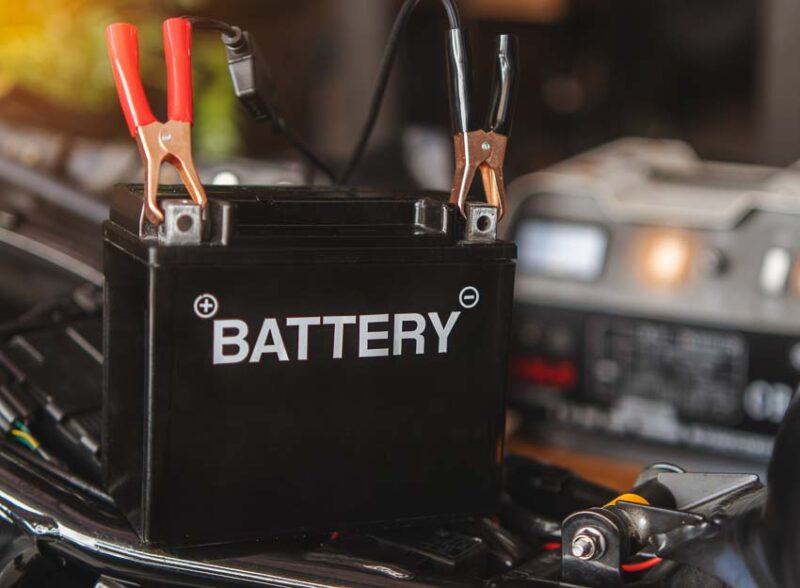
Follow these tips to maintain your electric snow blower’s battery and extend its life:
- Never store the snow blower with the battery plugged in.
- Charge the battery every six months.
- Store the battery in a cool, dry area from 50 to 75°F (10 to 21°C).
- Never let the battery freeze.
Completely discharging the battery will destroy it. When it gets down to one LED light bar, you should charge the battery.

